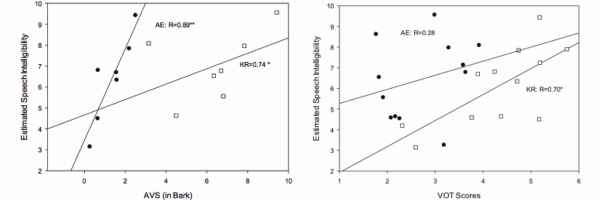Session Information
Date: Thursday, June 23, 2016
Session Title: Other
Session Time: 12:00pm-1:30pm
Location: Exhibit Hall located in Hall B, Level 2
Objective: The purpose is to compare acoustic models of speech intelligibility in individuals with the same disease (Parkinson’s disease, PD) but with different native languages, motivated by the observation that current knowledge of dysarthria has been accumulated primarily based on neuropathology-oriented, American English-centered and perceptually-driven approaches.
Background: Although speech characteristics of non-English speakers with dysarthria have been reported (e.g. French, German), the main focus was mostly on developing speech profiles of the disorder in their own languages. Rather, the current study aimed to directly compare the same dysarthria in two languages for the purpose of examining the nature of dysarthria. Its theoretical perspective is that phonological properties vary across languages, raising the possibility that the mapping of phonological/phonetic impairment to speech intelligibility may be language-specific at least to some degree. If we understood the effects of specific disease in which underlying neuropathology was fairly well known in different languages, the transformation between neuropathology and speech symptoms may be clearer.
Methods: 48 speakers participated: 12 AE speakers with PD, 12 AE-speaking healthy controls (HC), 12 Korean speakers with PD, and 12 Korean-speaking HC. In each language, speakers read a paragraph that is widely-used in studies of speech disorders. Acoustic measurements were made for 4 variables, including (1) acoustic vowel space (AVS), (2) VOT scores, (3) normalized pairwise variability index of vowels (nPVI-V), and (4) articulation rate (AR).
Results: Speakers with PD in both languages showed similar patterns compared to HC: reduced AVS and VOT scores, lower nPVI-V, and normal AR. However, the degree to which each parameter accounted for variation in speech intelligibility ratings appeared language-dependent. Figure 1 describes the primary differences of two parameters between the two languages: AVS and VOT scores. 
Conclusions: The results support that language variations should be considered in the clinical assessment/management process because languages with different sound systems yield a different set of acoustic predictors of speech intelligibility in dysarthria. This is an important issue considering the growing populations of bilinguals and non-English speakers in the US.
Part of data were presented at the Conference on Motor Speech Disorders, 2014.
To cite this abstract in AMA style:
Y. Kim, Y. Choi. A cross-linguistic approach to speech intelligibility in people with PD [abstract]. Mov Disord. 2016; 31 (suppl 2). https://www.mdsabstracts.org/abstract/a-cross-linguistic-approach-to-speech-intelligibility-in-people-with-pd/. Accessed December 7, 2025.« Back to 2016 International Congress
MDS Abstracts - https://www.mdsabstracts.org/abstract/a-cross-linguistic-approach-to-speech-intelligibility-in-people-with-pd/
